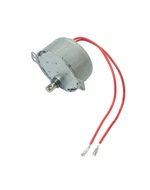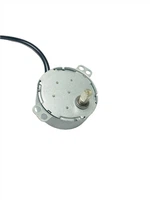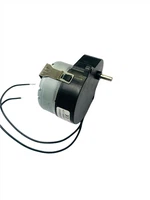Stepper Motor
Why Choose Us
Our certifications
The Taiwan factory of our company has passed the ISO9002 international quality system certification, the American standard UL quality certification, the European standard CE /EMC quality certification, and the RoHs environmental protection certification.
Have import and export rights
The domestic company has the right to import and export, and its products are exported to more than 30 countries, and it provides the most suitable motors and related technologies according to the different needs of customers.
Our products
Our company produces synchronous motors, bidirectional synchronous motors, hysteresis motors (HTS), sparrow machine motors, and powder metallurgy gears. DC brushless motors, planetary geared motors (LED UV), push rod motors, DC motors, DC geared motors, high self-made products, and continuously improve equipment quality production management to achieve more rapid and flexible services.
Our service
In order to meet customer requirements for product diversification, the company also imports Japanese Mabuchi motors as an agent, and 100% of the goods are picked up by Mabuchi warehouses, and can be delivered in Hong Kong and domestically.
A stepper motor is an electric motor whose main feature is that its shaft rotates by performing steps, that is, by moving by a fixed amount of degrees. This feature is obtained thanks to the internal structure of the motor, and allows to know the exact angular position of the shaft by simply counting how may steps have been performed, with no need for a sensor. This feature also makes it fit for a wide range of applications.
High Precision and Control
One of the main advantages of stepper motors is their ability to provide precise positioning and control. Stepper motors move in discrete steps, allowing for accurate position control and reproducibility. This property makes them ideal for applications that require precise movements, such as 3D printers, CNC machines, and robotics.
High Torque at Low Speeds
Stepper motors are known for their high torque, particularly at low speeds. This characteristic makes them suitable for applications that require high holding torque, such as in robotics and conveyor systems. Stepper motors can maintain their position without the need for external braking mechanisms or additional power, making them highly efficient in certain applications.
Cost-Effective Solution
Compared to other motor types, stepper motors offer a cost-effective solution for many applications. They are relatively inexpensive to manufacture and can operate with simple drive circuits, reducing overall costs. Additionally, since they don't require feedback sensors like encoders or resolvers, the overall system cost can be significantly reduced.
Easy to Control
Stepper motors are driven by digital pulses, making them easy to control and interface with microcontrollers or other control systems. The simplicity of their control system allows for straightforward integration with various electronic devices and automation systems. This ease of control makes stepper motors popular in hobbyist projects, prototyping, and educational applications.
No Servo Tuning Required
Unlike servo motors, stepper motors do not require complicated tuning processes for optimal performance. Servo motors typically need careful adjustment of gains, feedback loop parameters, and damping coefficients to achieve stable and accurate motion control. In contrast, stepper motors offer plug-and-play operation, simplifying the setup process and reducing the time required for implementation.
Types of Stepper Motor
Bipolar stepper motor
A bipolar stepper motor has an onboard driver that uses an H-bridge circuit to reverse the current flow through the phases. By energising the phases while alternating the polarity, all the coils can be put to work turning the motor.In practical terms, this means that the coil windings are better utilised in a bipolar than a standard unipolar stepper motor (which only uses 50% of the wire coils at any one time), making bipolar stepper motors more powerful and efficient to run. Although bipolar stepper motors are technically more complicated to drive, they tend to come with an inbuilt driver chip that handles the bulk of the necessary instructions and behaviours.
Hybrid stepper motor
Hybrid stepper motors allow for yet more precision, through techniques such as half-stepping and microstepping. Microstepping is a way of increasing the fixed number of steps within a motor by programming a driver to send an alternating sine/cosine waveform to the coils. Doing this often means that stepper motors can be set up to run smoother and more accurately than in a standard setup.Hybrid stepper motors usually have poles or teeth that are offset on two different cups around the outside of the magnet rotor. This also means steps and rotations can be more precisely controlled, as well as offering quieter operation, higher torque-to-size ratios and greater output speeds than standard stepper motors.
3D Printer
Stepper motors are essential components in 3D printers due to their precise control over the position and speed of the motor.Unlike traditional DC motors that rotate continuously, stepper motors move in small steps and enable precise positioning and holding of the printing head. This precise positioning is essential for creating 3D models.Stepper Motors also provides high torque at low speeds which ensures the printing head can move smoothly and maintain its position under different load conditions. This motor also offers excellent holding torque which prevents unwanted movement during printing.
CNC Machines
Stepper motors are a crucial component in CNC machines due to their unique characteristics of precisely aligning with different operating systems as per the requirement.Stepper motors have the ability to move in discrete steps with the help of electrical pulses, which results in exceptional positioning accuracy and repeatability. This precise control enables the creation of intricate designs with minimal error to ensure high-quality outputs.Stepper motors also offer excellent holding torque, which allows them to maintain their position even under different load conditions. This feature prevents the unwanted movement of the CNC machine during the operation. This feature is important in machining the intricate parts that require precise positioning and stability.


Robotics
Stepper motors are extensively used in robotics due to their exceptional controllability, precision, and torque.Stepper motors offer precise angular positioning and control rotation which makes them ideal for robotics applications that require accurate movement and fine control.Unlike traditional DC motors, stepper motors divide their steps into smaller steps, enabling precise positioning and accurate movement for the manipulation of robotics joints and effectors.Additionally, stepper motors offer high torque at low speeds which enables robots to handle heavy loads and overcome the initial forces effectively.
Industrial Automation
Stepper motors are widely used in various industrial automation devices such as conveyor belts, pick and place machines, and various automated systems due to precise positioning and accurate movement. Stepper motors have precise angular control and the ability to be easily integrated with digital control systems which makes them ideal for applications that require precise and repeatable movements. Stepper motors also offer precise positioning and control over the speed and direction of the motor which enables the accurate movement of the objects and becomes an ideal solution for conveyor belts and pick-and-place machines.
How to Choose Stepper Motor
Inertial Loads
Inertia is a measure of an object's resistance to a change in velocity. The larger an object's inertia, the greater the torque required to accelerate or decelerate it. Inertia is a function of an object's mass and shape. A system designer may wish to select an alternative shape or low-density material for optimal performance. If a limited amount of torque is available in a selected system, then the acceleration and deceleration times must increase. We recommend that the ratio of the system inertia to the rotor inertia not exceed 10:1. A gearbox may be used to help achieve this ratio.
Frictional Loads
All mechanical systems exhibit some frictional force. The designer of a stepper motor system must be able to predict elements causing friction within the system. These elements may be in the form of bearing drag, sliding friction, system wear, or viscosity of an oil-filled gear box (temperature dependent). The selected stepper motor must be able to overcome any systemic friction while providing the necessary torque to accelerate the inertial load.
Positioning Resolution
The positioning resolution required by the application may have an effect on the type of transmission used and/or selection of the stepper motor driver. For example: A lead screw with 5 threads per inch on a full-step drive provides 0.001 inch/step; Half-step provides 0.0005 inch/step; A microstep resolution of 25,400 steps/rev provides 0.0000015 inch/step.
How to Use a Stepper Motor
Step 1: Materials That I'm Using
In order to demonstrate how to use the stepper motor (a hybrid stepper motor), there are a few things that I will end up using.
Step 2: Stepper Motor Theory
Stepper motors are part of a class of motors known as brushless motors; these motors have a shaft but it does not physically touch anything in order to rotate. Rather, stepper motors work by utilizing electromagnets that are concentrically located around the shaft.The idea behind electromagnets is that when a voltage of any kind is applied to a coil surrounding the piece of "soft" metal, that metal becomes magnetized until the current stops flowing through the coil. The central shaft rotates as the coils surrounding the electromagnets are brought to various voltage states.
Step 3: Types of Stepper Motors
There are three main types of stepper motors that exist: Variable inductance motors, permanent magnet motors, and hybrid motors. Variable inductance motors only use the generated magnetic field to make the central shaft rotate and line up with the energized electromagnets. Permanent magnet motors are similar except that the central shaft is polarized to have magnetic north and south pole which will appropriately rotate to whichever electromagnets are turned on. The difference between this and the variable inductance motor is that the permanent magnet motor's central shaft does not have multiple "teeth"; Just a north and south pole.
Step 4: Unipolar Vs Bipolar Stepper Motors
There are two types of stepper motors: Unipolar and bipolar stepper motors. On a fundamental level, these two types work exactly the same way; Electromagnets are turned on in a sequential fashion, inducing the central motor shaft to spin.The difference between the two types is the voltage levels. A unipolar stepper motor only operates with positive voltage, so the high and low voltages applied to the electromagnetic coils would be something like 5V and 0V. A bipolar stepper motor has two polarities, positive and negative, so its high and low voltages would be something like 2.5V and -2.5V.
The Importance of Regular Lubrication and Cleaning
Proper lubrication and cleaning are fundamental aspects of maintaining linear stepper motors. Over time, dust, debris, and other contaminants can accumulate on the motor's moving parts, causing friction, heat, and premature wear. Regularly cleaning the motor and applying suitable lubricants can prevent these issues and extend the motor's lifespan.When cleaning the motor, it is important to use non-abrasive materials and solvents that are compatible with the motor's components. Gently removing dirt and dust from the motor's exposed areas and ensuring that the internal components are free from debris is crucial. Additionally, lubricating the linear bearings, threaded rods, and lead screws with appropriate lubricants will effectively reduce friction and prevent excessive wear.
Implementing Proper Environmental Protection Measures
Linear stepper motors are exposed to various environmental factors that can affect their performance and longevity. Factors such as moisture, dust, temperature variations, and vibrations can have a significant impact on the motor's reliability. Implementing proper environmental protection measures can help shield the motor from these external elements, ensuring its optimal functioning.One effective method of environmental protection is the use of protective covers or enclosures. These covers can shield the motor from dust, debris, and moisture, preventing the accumulation of contaminants that can obstruct the motor's movement. Additionally, using temperature control measures such as cooling fans or heat sinks can help regulate the motor's operating temperature, preventing overheating and potential damage.
Optimizing Motor Voltage and Current
To maximize the lifespan of linear stepper motors, it is vital to operate them within their specified voltage and current ranges. Operating the motor beyond these limits can lead to overheating, excessive strain on the components, and eventual failure. Therefore, it is crucial to ensure that the motor's voltage and current settings are correctly configured.By referring to the motor's datasheet or consulting with the manufacturer, you can determine the optimal voltage and current values for your specific application. It is crucial to use a high-quality power supply that provides stable and accurate voltage regulation. Additionally, implementing motor driver circuitry with features like current limiting and protection mechanisms can effectively safeguard the motor from potential damage caused by overvoltage or excessive current.
Regular Inspections and Maintenance Checks
Performing regular inspections and maintenance checks is a proactive approach to identify potential issues or abnormalities before they escalate and cause major problems. These inspections should include a comprehensive examination of various motor components like the bearings, belts, gears, and wiring connections.During the inspections, it is vital to look for signs of wear, corrosion, loose connections, and other potential issues. Addressing these issues promptly can prevent further damage and ensure the motor's optimal performance. Additionally, checking the motor's mechanical alignment and adjusting it if required can prevent misalignment-related problems that may lead to premature wear and reduced lifespan.
Our Factory
Shenzhen Songgang Technology Industrial Co., Ltd. is a branch of Songgang International Group, headquartered in Hong Kong. It is a factory specializing in the production of various types of motors. There are factories in Taiwan and China to produce different types of motors.The Taiwan factory is the only metal gear synchronous motor professional manufacturer, adhering to the highest service level and best quality performance, serving domestic and foreign manufacturers. The domestic company has the right to import and export, and its products are exported to more than 30 countries, and it provides the most suitable motors and related technologies according to the different needs of customers.

certificate

















